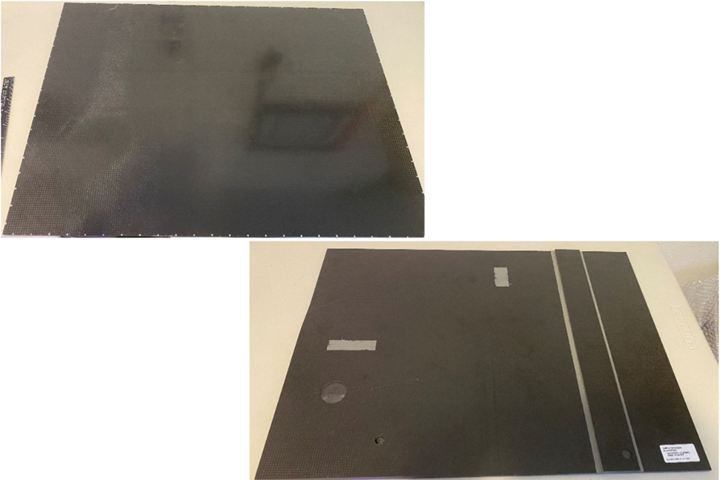Dolphicam2 NDT system identifies flaws in CFRP panel in one setup
A second benchmark study on a CFRP NDI Proficiency specimen 1A assesses NDT equipment and personnel, successfully characterizes all flaws in panel.
(Bottom) Photograph of the bottom face of the panel showing the ply build ups/sound dampers and (top) shows the top face of the panel (the “inspection side”). Photo Credit: Dolphitech
In March 2022, Dolphitech (Gjøvik, Norway) performed a capability study on a carbon fiber-reinforced plastic (CFRP) panel made to the specification of a Federal Aviation Administration (FAA) NDI Proficiency specimen 2A to determine the effectiveness of its dolphicam2 ultrasonic platform for nondestructive testing (NDT). With feedback on this inspection report, the company has now presented further results from a second panel, NDI Proficiency specimen 1A, to further assess both NDT equipment and personnel.
Dolphitech says the 24- x 18-inch panel (see both sides of the panel above) featured various manufacturing flaws typical of aerospace composites, including Carbospheres, pillow inserts, grinding disk cut, flat bottom holes, left-in prepreg backing, adhesive backing, grease, Grafoil and sealant. The panel was a 32 ply cocured substructure (16-ply main laminate with 16-ply bonded stiffener substructure and a 16-ply bonded laminate). This corresponds to a nominal thickness over the majority of the panel of ~0.128 inch with a maximum thickness of ~0.3 inch over the stiffeners and bonded area. A dolphicam2 and a TRM-AF-3.5MHz transducer module (TRM) were both used for the inspection.
Final results note that, using this equipment, all manufactured flaws present (mentioned above) in the composite panel were clearly characterized and resolved in a single setup. Moreover, Dolphitech says flaws could be sized, and were found to be in good agreement with nominal dimensions.
For additional details, request the full report here.
Related Content
-
Sulapac introduces Sulapac Flow 1.7 to replace PLA, ABS and PP in FDM, FGF
Available as filament and granules for extrusion, new wood composite matches properties yet is compostable, eliminates microplastics and reduces carbon footprint.
-
Plant tour: Teijin Carbon America Inc., Greenwood, S.C., U.S.
In 2018, Teijin broke ground on a facility that is reportedly the largest capacity carbon fiber line currently in existence. The line has been fully functional for nearly two years and has plenty of room for expansion.
-
The lessons behind OceanGate
Carbon fiber composites faced much criticism in the wake of the OceanGate submersible accident. CW’s publisher Jeff Sloan explains that it’s not that simple.














